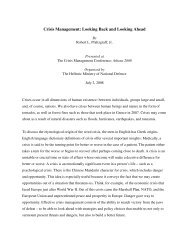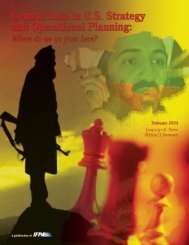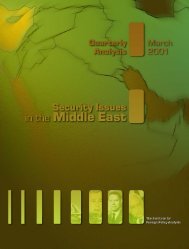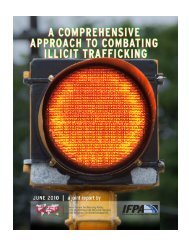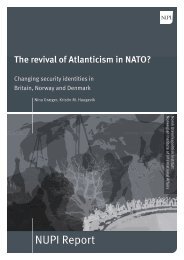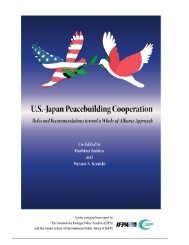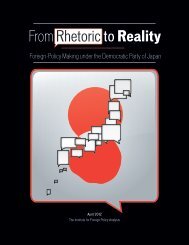US Peacebuilding in Afghanistan - Institute for Foreign Policy Analysis
US Peacebuilding in Afghanistan - Institute for Foreign Policy Analysis
US Peacebuilding in Afghanistan - Institute for Foreign Policy Analysis
Create successful ePaper yourself
Turn your PDF publications into a flip-book with our unique Google optimized e-Paper software.
of the government. Unlike its predecessor, DIAG is district-focused, not militia-focused, and isbe<strong>in</strong>g implemented throughout <strong>Afghanistan</strong>. From 2005 until late 2010, the program disbanded743 IAGs and collected 51,873 weapons. 23 DIAG faces a number of challenges: poor securitythat makes implantation very dangerous, local and tribal leaders who are generally unwill<strong>in</strong>g todisarm and demobilize, and some prov<strong>in</strong>cial and district leaders who do not supportimplementation.Both the ANBP and DIAG were programs led by Japan, UNDP, and the government of<strong>Afghanistan</strong> and were supported by other donor nations, <strong>in</strong>clud<strong>in</strong>g the United States. The UnitedStates engages <strong>in</strong> little active leadership <strong>in</strong> the implementation of DDR <strong>in</strong> <strong>Afghanistan</strong>, butsupports it through <strong>in</strong>teragency ef<strong>for</strong>ts and fund<strong>in</strong>g – ma<strong>in</strong>ly from the Department of State andthe U.S. Agency <strong>for</strong> International Development (<strong>US</strong>AID). Yet the biggest effect the UnitedStates has on DDR <strong>in</strong> <strong>Afghanistan</strong> is not its <strong>in</strong>volvement with<strong>in</strong> it, but the actions it takes outsideof it.The <strong>in</strong>itial U.S. plan <strong>for</strong> security sector re<strong>for</strong>m – specifically how to raise the ANA and ANP –contradicted the <strong>in</strong>ternational plan <strong>for</strong> DDR as well as DDR best practices. Ideally, thepreponderance of the Afghan Security Forces could have been drawn from the AMF <strong>in</strong>itially,re<strong>in</strong>tegrat<strong>in</strong>g them <strong>in</strong>to a governmental structure <strong>in</strong>stead of releas<strong>in</strong>g them <strong>in</strong>to a bleak economicenvironment. In addition to provid<strong>in</strong>g <strong>for</strong>mer combatants with work (decreas<strong>in</strong>g the likelihoodthat they would jo<strong>in</strong> <strong>in</strong>surgent groups), <strong>in</strong>tegrat<strong>in</strong>g <strong>for</strong>mer militiamen <strong>in</strong>to the military wouldhave provided the ANA with proven battlefield leaders. There would have been challenges tosuch a program: tra<strong>in</strong><strong>in</strong>g would still be required on civil rights, professional military standards,and higher-level skills; personal connections acquired <strong>in</strong> the militias would have to be broken topromote unity of command with<strong>in</strong> the Army; and ethnic proportions with<strong>in</strong> the ANA’sleadership and rank-and-file would need to be adjusted. In spite of these challenges, re<strong>in</strong>tegrationof the AMF <strong>in</strong>to the ANA would have given the ANBP a better chance of success (some 70percent to 80 percent of ANBP re<strong>in</strong>tegration alumni are dissatisfied with the services theyreceived). 24 The United States’ <strong>in</strong>sistence on start<strong>in</strong>g the ANA from scratch prevented suchlarge-scale re<strong>in</strong>tegration measures, with only 2 percent of new ANA and ANP recruits com<strong>in</strong>gfrom the AMF through ANBP.The second way <strong>in</strong> which the United States has <strong>in</strong>advertently derailed the DDR process from theoutside is through rearmament programs. These programs have come <strong>in</strong> many <strong>for</strong>ms over thecourse of the conflict, but have become a ma<strong>in</strong>stay (even if controversial) of U.S.counter<strong>in</strong>surgency practices. Inspired by the legitimization of Sunni militias as part of theAwaken<strong>in</strong>g Councils <strong>in</strong> Iraq <strong>in</strong> 2007 and 2008, U.S. military leaders have supported the rearm<strong>in</strong>gof tribal or local militias throughout <strong>Afghanistan</strong> <strong>in</strong> order to ga<strong>in</strong> support <strong>in</strong> fight<strong>in</strong>g the Taliban.23 UN Development Programme, “<strong>Afghanistan</strong> Disbandment of Illegal Armed Groups: Third Quarter ProjectProgress Report [2010],” http://www.undp.org.af/Projects/03%20QuarterRep.2010/2010-11-01-%20Third%20Quarter%20Progress%20Report%20of%20DIAG.pdf, 1.24 Hartzell, 10.9




